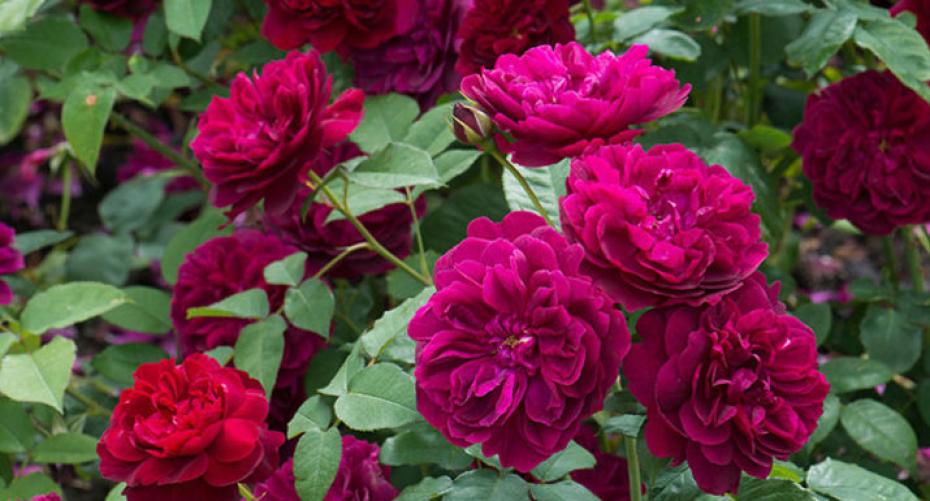Even the smallest garden has space for a delicious David Austin rose
'Darcey Bussell' (pictured above)
Brighten up the patio or create a focal point with a stunning David Austin rose in a large decorative container. Many of the smaller English shrub roses respond well to hard pruning to keep them compact and they will be quite happy in a container; provided it is large enough. Don’t skimp on the container as a small pot will lack impact and the rose will only thrive for a couple of years. Don’t go for a pot with a narrower neck than body as you won’t be able to get the rose out to re-pot it without breaking the pot. The container needs to be at least 45cm (18”) deep and preferably as wide. Make sure the container has adequate large drainage holes in the bottom. Roses are one of the best value garden plants, often flowering all summer and into autumn, from the end of May to the beginning of November.

'Desdemona'
Planting
Cover the drainage holes with a large piece of broken crock; if you don’t do this they will eventually block with silt and the roots will become waterlogged and that will be the end of your plant. If possible place a forkful of well-rotted farmyard manure in the bottom of the pot then top up with good quality peat free compost or a dedicated rose compost. Plant the rose with the grafting point just below the soil surface. If you are planting a bare root rose, usually done from late autumn to early spring when the plant is dormant, soak the roots first in a bucket of water. Use David Austin mycorrhizal fungi when planting, sprinkle it on the roots of the bare root plant or fork it into the hole if planting a container specimen. The fungi enable the roots to absorb more water and nutrients than it would normally, ensuring your plant will be as healthy as possible. Firm down the soil after planting to eliminate any air pockets.

'Lady Emma Hamilton'
Aftercare
Place the container, preferably in a sunny position, and keep well watered, especially in dry weather. Keep the compost just damp. Cut the stems back to about 30cm (12”) about late October, unless the rose is still flowering and the weather is mild, in which case leave the hard prune until about the beginning of March. Cut off the stem just above an outward facing eye. Cut out any diseased or dead stems and any which are going across the centre of the plant. When you dead head the rose cut the stem right back to a healthy bud, unless there are more buds on the stem. In spring give a feed of good quality rose fertiliser, such as Toprose.
After about 3 – 4 years the rose would benefit from removing from the container, taking out all the old compost from the pot and as much as possible from around the roots and re-potting, as outlined above.

'Roald Dahl'
Varieties recommended by David Austin
All these varieties are English shrub roses bred by David Austin and have exceptional fragrance, a good long flowering period, plenty of blooms and relatively good disease resistance.
- Darcey Bussell
Bright crimson with a fruity fragrance.
- Desdemona
Pale pinky-peach opening to white.
- Lady Emma Hamilton
Orange with touches of pink and yellow.
- Roald Dahl
Peach with a Tea fragrance.

'Sir Walter Scott'
- Sir Walter Scott
Mid-pink with a strong Old Rose fragrance.




![Kingsbury-bench-05[1].jpg](http://www.hayesgardenworld.co.uk/cdn/shop/files/Kingsbury-bench-05_5B1_5D.jpg?v=1712162737&width=1500)
![Kingsbury-bench-01[1].jpg](http://www.hayesgardenworld.co.uk/cdn/shop/files/Kingsbury-bench-01_5B1_5D.jpg?v=1712161065&width=1500)
![tw17a-4947_0[1].jpg](http://www.hayesgardenworld.co.uk/cdn/shop/files/tw17a-4947_0_5B1_5D.jpg?v=1712161495&width=1500)
![tw17a-4947_tenbury_5ft[1].jpg](http://www.hayesgardenworld.co.uk/cdn/shop/files/tw17a-4947_tenbury_5ft_5B1_5D.jpg?v=1712161172&width=1500)
![tw17a-4952_tenbury_4ft[1].jpg](http://www.hayesgardenworld.co.uk/cdn/shop/files/tw17a-4952_tenbury_4ft_5B1_5D.jpg?v=1712161034&width=1500)
![thumbnail_IMG_1565-kik_2[1].jpg](http://www.hayesgardenworld.co.uk/cdn/shop/files/thumbnail_IMG_1565-kik_2_5B1_5D.jpg?v=1712226536&width=1500)
![thumbnail_IMG_1565-kik_1[3].jpg](http://www.hayesgardenworld.co.uk/cdn/shop/files/thumbnail_IMG_1565-kik_1_5B3_5D.jpg?v=1712159637&width=1500)



![WD-XgESA[1].jpeg](http://www.hayesgardenworld.co.uk/cdn/shop/files/WD-XgESA_5B1_5D.jpg?v=1712159609&width=1500)